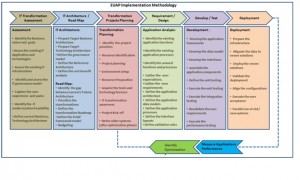Following the preceding series of this blog, now it’s time to know how to adopt EUAP. Legacy Application Migration is clearly one of the most complex IT challenges facing the IT industry today. But when you follow a systematic approach – the chances are more to be successful in the change process. Hence we follow a very organized approach from assessment to monitoring and management phases. EUAP approach is an IT transformation approach that is going to replace or upgrade the IT applications assets. To be very successful in adopting the unified platform requires unique methodology. Aspire defined the EUAP implementation methodologies that covers from assessment to optimization phases of IT transformation.
The preceding diagram shows the EUAP implementation methodology designed and followed by Aspire unified application platform practice. The EUAP implementation methodology includes six primary phases and two secondary phases. They are as follows:
| UEAP Methodology Phase | Description |
| IT Assessment | Assess the existing IT infrastructure, applications and governance model and conduct the feasibility study |
| IT Architecture / Roadmap | Based on the assessment, define the current, target IT architecture, and identify the roadmap to meet the target IT. |
| Transformation Planning | Based on the roadmap, identify the list of projects to be conducted to meet the destination and plan each project execution |
| Requirement / Design | Take each project identified in the planning phase, gather detailed requirements, and design application architecture. |
| Develop / Test | Develop the application design solution that meet the requirement and execute various testing to qualify the application |
| Deployment | Deploy the qualified application solution in the IT infrastructure. |
| Measurement | Measuring the application performance is a postproduction phase and it is an incessant phase. |
| Optimization | Optimization phase would identify the improvement opportunities and trigger the planning phase to upgrade the application maturity. |
All above phases include various activities to execute the phase successfully. The EUAP adoption requires to build the application platform framework before implement the business solutions. However, the platform framework development should also be executed from planning to deployment phases. As per the reference architecture, every component development must be executed as part of the EUAP implementation phases.
Next is the implementation process. One of the important phases of EUAP implementation methodology is IT architecture and roadmap phase. In that phase, the implementation team focuses on defining the current IT architecture based on the assessment conducted in the previous phase and required architecture as target architecture to meet the long-term business vision and goals. The importance of defining highly scalable target architecture is going to ensure the real success of EUAP adoption and return of investment. The EUAP architecture implementation roadmap guides the implementation team to conduct the IT transformation in systematic approach. The below image will articulate the sample EUAP implementation roadmap.
Primarily, the EUAP must be adopted as several phases that start from inception. The inception phase will cover the assessment, roadmap and planning phases of the implementation methodology. The EUAP framework implementation would be the first development to begin the transformation journey. There should be a measurement phase to identify the performance and scalability issues in the developed framework and fine-tune it. While adopting the EUAP framework and application solutions, the downgrade of the legacy and aged applications should come down. Once a particular EUAP business application deployed in the IT infrastructure, the corresponding legacy application should be retired from the IT portfolio. However, it must be destroyed only at the end of implementation.
With ever improvising technology, the Legacy application migration process should be clearly defined and followed genuinely – in order to efficiently manage the change. Don’t you agree? You may also think – when there are so many players in the market with similar solution, why should I consider Aspire’s EUAP? Your question will be answered in the next series of this blog.
To read the previous episodes of this blog: Series 1; Series 2
For any queries, please feel free to drop me an email at:
- New Whitepaper: Top 5 Frameworks and Toolkits for better User Experience - September 6, 2013
- Testimonial: BY-ESN Founder Folkert Rosenkamp (Video) - August 22, 2013
- 5 Mandatory Roles required for Successful Product Development - August 12, 2013








Comments